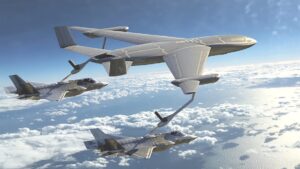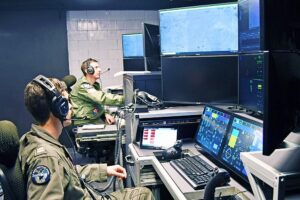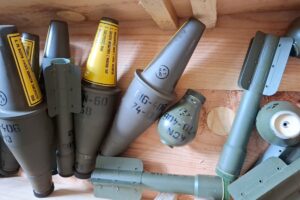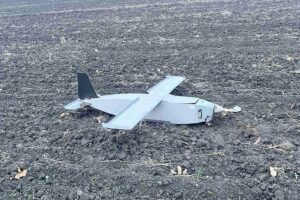More dronestock Photos and Videos from Arras available to license for all your audiovisual projects
The post Aerial View Of The Belfry And The City Hall In Arras, France – Dronestock footage on HOsiHO.com appeared first on DRONESTAG.
More dronestock Photos and Videos from Arras available to license for all your audiovisual projects
The post Aerial View Of The Belfry And The City Hall In Arras, France – Dronestock footage on HOsiHO.com appeared first on DRONESTAG.
The DJI Air 3 and DJI Air 3S are two impressive mid-tier drones, but the Air 3S is ever-so-slightly better. So between the DJI Air 3 vs. DJI Air 3S, should you upgrade from the standard model to the newer “S” version?
Since both models come in at the same price point (typically $1,099), there’s little reason why the DJI Air 3S shouldn’t be the go-to choice for new buyers seeking a high-quality, powerful camera drone that won’t bust your budget the way something like the $2,149 DJI Mavic 3 Pro easily could.
If you’re seeking the best photography drone for the money, the DJI Air 3S easily beats out the DJI Air 3. For new buyers wondering if they should buy the DJI Air 3 vs. DJI Air 3S, the answer is simple: DJI Air 3S.
The only reasons why the DJI Air 3 might make sense over the DJI Air 3S is:
The real question is: if you already have a DJI drone, say the DJI Air 3, is it worth upgrading?
The Air 3S, which launched in October 2024, offers an impressive upgrade to the the DJI Air 3, which debuted in July 2023. Its obstacle sensing is superior (particularly at night), it’s got a new Panorama mode, and its internal storage is seriously useful.
Here’s a look at the DJI Air 3 vs. DJI Air 3S, and whether current DJI pilots should consider upgrading to the latest model in the DJI Air line.
Most people considering the DJI Air 3S are likely those who already have (or at least have heavily considered) the DJI Air 3, which is the predecessor. Here’s how the two drones compare on some key features:
| Feature | DJI Air 3 | DJI Air 3S |
|---|---|---|
| Price | $1,099 | $1,099 |
| Obstacle Sensing | Omnidirectional | Omnidirectional + Nightscape |
| Panorama Mode | Not available | Free Panorama mode |
| Internal Storage | 8GB | 42GB |
| Camera Resolution | 48 MP | 50 MP |
| Sensor (wide-angle camera) | 1/1.3-inch CMOS | 1-inch CMOS |
| Sensor (medium tele camera) | 1/1.3-inch CMOS | 1/1.3-inch CMOS |
| Normal ISO range | 100-6400 (video) 100-6400 (photo) |
100-12800 (video) 100-12800 (photo) |
| Weight | 720 grams | 724 grams |
| Dimensions (folded without propellers) | 207×100.5×91.1 mm (L×W×H) | 214.19×100.63×89.17 mm (L×W×H) |
| Max Flight Time | 46 minutes | 45 minutes |
| Max Flight Distance | 32 km | 32 km |
| Max Wind Speed Resistance | 12 m/s | 12 m/s |
| Target Audience | Intermediate to advanced drone users | New buyers looking for an all-in-one package |
So what do all those features and specs mean in practice? Here are 4 key upgrades in the DJI Air 3S that you won’t get with just the DJI Air 3.
Sure, the Air 3 boasts omnidirectional obstacle sensing, but the Air 3S has upgraded sensing technology that makes it even safer and easier to fly. It all comes down to forward-facing LiDAR technology. Normally considered high-end technology for mapping methods like photogrammetry, DJI has implemented such previously top-tier tech into what’s essentially a consumer drone. For pilots today, that means the DJI Air 3S can better detect obstacles and navigate safely, even in low-light conditions.
The Air 3S also includes a new, free Panorama mode that allows for photographers to better generate those ultra-wide-angle shots with minimal effort. Up until now, the steps to make a panoramic photo with your drone were a bit complicated. Many photographers resort to third-party panorama software like PanoVolo to stitch photos together for them to make panoramas.
And sure, PanoVolo is still easy to use, but having the mode within the drone is much easier. No separate lens, third-party software nor extensive post-editing to get those wide-angle views.
Once you upgrade to the DJI air 3S, you likely won’t need SD cards (or in the case of drones, microSD cards) at all. The Air 3S bumps up its internal storage from a modest 8GB to a spacious 42GB.
Typically a 4K video with a resolution of 3840 x 2160 pixels takes up about 15–30 GB of space per hour. That means you could take easily an hour worth of high resolution footage on this drone, and that’s a conservative estimate. It’s very likely more. That’s a massive upgrade, allowing you to capture far more footage without the constant worry of running out of space or fiddling with external cards.
While the Air 3 already had an impressive 48 MP camera, the Air 3S edges it out with a slight improvement to 50 MP. This bump may not seem huge, but it does deliver a bit more clarity and detail, especially in shots where resolution really counts.
There are a few (minor) drawbacks with the Air 3S, though they’re unlikely to be deal-breakers:
Since the DJI Air 3 and Air 3S retail at the same price, if you’re in the market for a new drone, the choice is clear: the DJI Air 3S is the better deal. With the upgraded obstacle sensing, additional storage, and minor camera improvements, it’s a more robust option at no extra cost. That said, availability could be a challenge due to customs and inventory issues, so it’s worth checking if the Air 3S is even an option in your area.
While the DJI Air 3S offers some attractive upgrades, they don’t quite justify an upgrade for current Air 3 owners. The enhancements—omnidirectional obstacle sensing, slightly improved camera, and added internal storage—are all nice-to-haves, but likely not game-changers for most users.
Unless you truly lose memory cards like pennies in your couch — or unless you’re doing complicated flights in the dark where improved obstacle avoidance is necessary, skip it. Of course, if those things DO apply to you, then selling your current DJI Air 3 and putting the funds to an Air 3S may make sense.
But for most folks who already own an Air 3, then waiting for the next big leap in drone technology (like the rumored DJI Mavic 4) may be the wiser move.
After all, DJI is known for releasing products at a quick pace, and a truly groundbreaking update may not be far off. The DJI Air 3 already has solid specs, and unless you’re in desperate need of more storage or a slight edge in obstacle avoidance, the Air 3 should continue to meet most of your needs for some time.
The post DJI Air 3 vs. DJI Air 3S: is it worth the upgrade? appeared first on The Drone Girl.
 – Lockheed Martin’s Skunk Works advanced projects division has put forward a new notional vision for a stealthy pilot-optional aerial refueling tanker. This comes as the U.S. Air Force is refining requirements for a future Next Generation Air-Refueling System (NGAS) ‘system of systems’ and amid serious concerns about how the service expects to pay for […]
– Lockheed Martin’s Skunk Works advanced projects division has put forward a new notional vision for a stealthy pilot-optional aerial refueling tanker. This comes as the U.S. Air Force is refining requirements for a future Next Generation Air-Refueling System (NGAS) ‘system of systems’ and amid serious concerns about how the service expects to pay for […] The U.S. Navy tested its Unmanned Carrier Aviation Mission Control Station’s (UMCS) ability to command an unmanned aircraft in flight for the first time Nov. 5, paving the way for future unmanned aviation operations. As part of an effort to advance technology for future Collaborative Combat Aircraft (CCA), General Atomics Aeronautical Systems, Inc. (GA-ASI) initiated […]
The U.S. Navy tested its Unmanned Carrier Aviation Mission Control Station’s (UMCS) ability to command an unmanned aircraft in flight for the first time Nov. 5, paving the way for future unmanned aviation operations. As part of an effort to advance technology for future Collaborative Combat Aircraft (CCA), General Atomics Aeronautical Systems, Inc. (GA-ASI) initiated […] Earlier this summer, Polish PGN-60 rifle grenades began to appear in the hands of various Ukrainian units. These 68mm fin-stabilised, High-Explosive Anti-Tank (HEAT) grenades were developed in the 1950s, to provide Polish infantry with a ranged anti-tank and anti-personnel weapon. Introduced in the early 1960s they were used in conjunction with the specially adapted Karabinek-granatnik […]
Earlier this summer, Polish PGN-60 rifle grenades began to appear in the hands of various Ukrainian units. These 68mm fin-stabilised, High-Explosive Anti-Tank (HEAT) grenades were developed in the 1950s, to provide Polish infantry with a ranged anti-tank and anti-personnel weapon. Introduced in the early 1960s they were used in conjunction with the specially adapted Karabinek-granatnik […] During the 70th Anniversary Review Ceremony of the South Korean Ministry of Defense and Self-Defense Forces on November 9, 2024, Japan’s Ground Self-Defense Force (JGSDF) presented a groundbreaking piece of technology—the 10kW-class high-power laser electronic warfare (EW) combat truck. Developed by Japan’s Defense Acquisition Agency, this state-of-the-art laser system marks a significant advancement in Japan’s […]
During the 70th Anniversary Review Ceremony of the South Korean Ministry of Defense and Self-Defense Forces on November 9, 2024, Japan’s Ground Self-Defense Force (JGSDF) presented a groundbreaking piece of technology—the 10kW-class high-power laser electronic warfare (EW) combat truck. Developed by Japan’s Defense Acquisition Agency, this state-of-the-art laser system marks a significant advancement in Japan’s […] Ten Russian drones strayed into neighbouring countries during record 145-drone attack on Ukraine on Sunday. A second Russian drone was discovered in Moldova* on Sunday, the country’s police reported. The unmanned aircraft was found near Borosenii Noi village in Rîșcani district, with explosive ordnance teams deployed to the cordoned site. The discovery follows an earlier […]
Ten Russian drones strayed into neighbouring countries during record 145-drone attack on Ukraine on Sunday. A second Russian drone was discovered in Moldova* on Sunday, the country’s police reported. The unmanned aircraft was found near Borosenii Noi village in Rîșcani district, with explosive ordnance teams deployed to the cordoned site. The discovery follows an earlier […]Vets to Drones and Baltimore Forensics Host a Day of Hands-On Flying, Talks, and Networking Event Overview On Saturday, November 23, Vets to Drones and Baltimore Forensics invite veterans and public safety personnel to Oriole Park at Camden Yards for a unique, drone-centered event. Running from 9 a.m. to 4 p.m., the event aims to […]
The post Veterans and Public Safety Personnel Event at Camden Yards to Explore Drone Opportunities appeared first on DRONELIFE.
Stakeholders expect Congress to pass legislation to allow local police to interdict drones By DRONELIFE Features Editor Jim Magill The National Football League has reported that during the 2023 season it detected more than 2,800 improper drone flights at its stadiums in violation of FAA-imposed temporary flight restrictions. With the growing number of incidents involving […]
The post Will Congress Empower Local Police to Counter Unauthorized Drone Flights? appeared first on DRONELIFE.
Brazil’s DECEA Selects VEGA UTM for Nationwide Drone Traffic Management, Paving the Way for Advanced Airspace Integration in Forestry, Agriculture, and Mining by DRONELIFE Staff Writer Ian J. McNabb Brazil-based Unmanned Traffic Management (UTM) developer and High Lander subsidiary BIRDS recently announced that their VEGA UTM product had been selected by the Brazilian air traffic […]
The post Brazilian Drone Industry Takes Flight: BIRDS’ VEGA UTM Selected for National Airspace Modernization Project appeared first on DRONELIFE.



